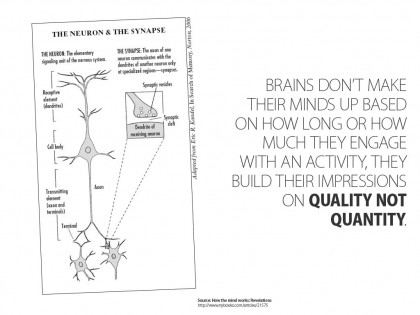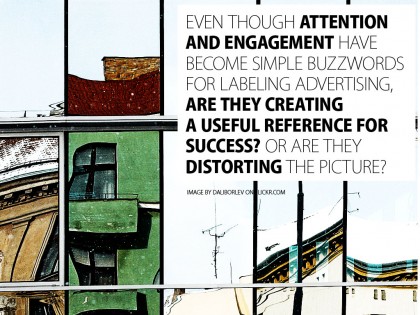When attention and engagement becomes less important in advertising and marketing, things are going to get a whole lot healthier.
- 1. This, the last from a series of posts I’ve published during the last week questioning some of the terminology we use as advertisers and marketers. (narrative, content, individuals).
2. It’s an idea, and hopefully, during the next couple of weeks, I will be able to elaborate and present examples that prove my point: That the terminology we use needs to change if we are going to build better, healthier marketing in a new brand landscape. Where we are allowed access to peoples personal lives, and where positioning a brand means something completely different than telling a story about it.
The problem with attention is that it becomes a reference to quantity, not quality, often leading to success metrics’ related to time or clicks. Which bears little relevance to positioning the brand or product in any way. Brains don’t make their minds up based on how long or how much they engage with an activity, they build their impressions on quality not quantity. read more…. (Although, quantity has always been kind of a life west for bad communication).

The opportunity we get from thinking outside of attention and engagement is that it opens the advertising to a much healthier degree of brand and product positioning. Because we can say that the goal of the advertising is to create value, in a way that puts no demand on stealing time away from people, keeping people interested long enough to tell a full story, or limiting our marketing to those who are interested enough in our advertising to actually spend a lot of time with it.
- As I’ve noted before to marketers: “People don’t care about your brand all the time, they care about it sometimes.”. We (the advertising business) need to keep in mind that people don’t care about advertising, at least not advertising the way we see it. And that making stuff interesting enough to create attention isn’t a decisive element of positioning.
Thinking outside attention and engagement also opens up the strategic and creative process for the new brand landscape, the Everyday Life, saying that the goal of any advertising or marketing activity is to create something valuable – without limitations on what form or format this will take. Be it a story, an exchange of ideas, an object or a utility etc..
If we remove the inherent need for time or narrative from the process – where would our ideas go?
- - Let me use social media as an example. Our focus on attention and engagement frightens marketers as they see SM as something very time consuming, but this very seldom needs to be the case. SM presents a whole range of abilities that companies and organizations would find valuable outside the metric of attention and engagement: Authenticity, relevance and trust being some of them.
My question is simple. Even though attention and engagement have become simple buzzwords for labeling advertising, are they creating a useful reference for success? Or are they distorting the picture?
